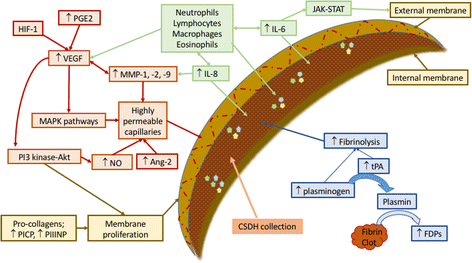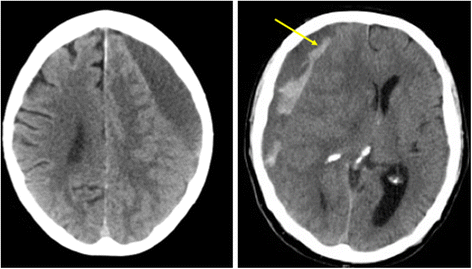Pathophysiology of chronic subdural haematoma: inflammation, angiogenesis and implications for pharmacotherapy
- PMID: 28558815
- PMCID: PMC5450087
- DOI: 10.1186/s12974-017-0881-y
Pathophysiology of chronic subdural haematoma: inflammation, angiogenesis and implications for pharmacotherapy
Abstract
Chronic subdural haematoma (CSDH) is an encapsulated collection of blood and fluid on the surface of the brain. Historically considered a result of head trauma, recent evidence suggests there are more complex processes involved. Trauma may be absent or very minor and does not explain the progressive, chronic course of the condition. This review focuses on several key processes involved in CSDH development: angiogenesis, fibrinolysis and inflammation. The characteristic membrane surrounding the CSDH has been identified as a source of fluid exudation and haemorrhage. Angiogenic stimuli lead to the creation of fragile blood vessels within membrane walls, whilst fibrinolytic processes prevent clot formation resulting in continued haemorrhage. An abundance of inflammatory cells and markers have been identified within the membranes and subdural fluid and are likely to contribute to propagating an inflammatory response which stimulates ongoing membrane growth and fluid accumulation. Currently, the mainstay of treatment for CSDH is surgical drainage, which has associated risks of recurrence requiring repeat surgery. Understanding of the underlying pathophysiological processes has been applied to developing potential drug treatments. Ongoing research is needed to identify if these therapies are successful in controlling the inflammatory and angiogenic disease processes leading to control and resolution of CSDH.
Keywords: Angiogenesis; Chronic subdural haematoma; Drug therapy; Head injury; Inflammation.
Figures




References
-
- Ommaya AK, Yarnell P. Subdural haematoma after whiplash injury. Lancet. 1969;2(7614):237–9. - PubMed
Publication types
MeSH terms
Grants and funding
LinkOut - more resources
Full Text Sources
Other Literature Sources
Medical

